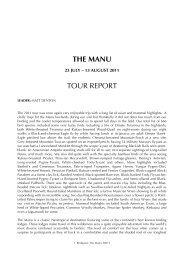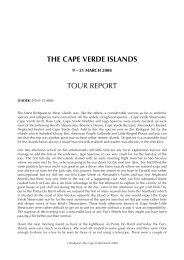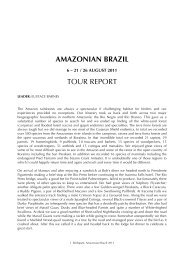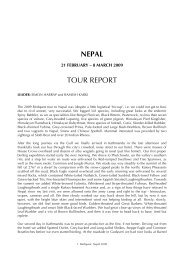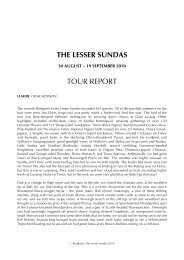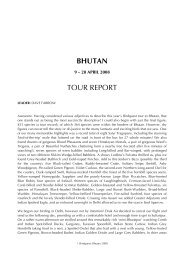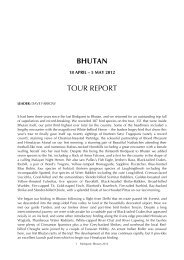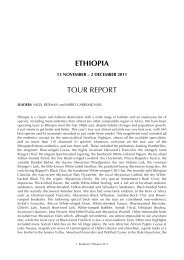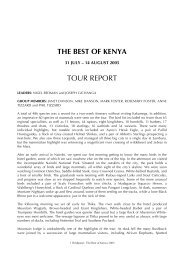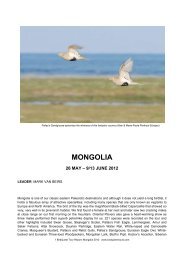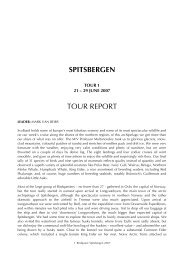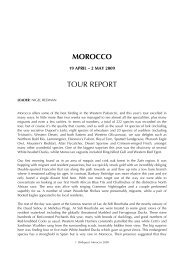INDONESIA (REMOTE EASTERN) REP 10 - Birdquest
INDONESIA (REMOTE EASTERN) REP 10 - Birdquest
INDONESIA (REMOTE EASTERN) REP 10 - Birdquest
Create successful ePaper yourself
Turn your PDF publications into a flip-book with our unique Google optimized e-Paper software.
looked. The only real ‘moment’ was in the middle, when one moved from one bamboo pole to the<br />
other. An ill-advised glance down revealed the gushing river and gave the illusion that one was being<br />
swept away. It was heartening having done this, to see that even the porters were having some<br />
problems – though they were carrying our heavy bags at the time! Once across, we managed to<br />
persuade the porters to carry our bags for a few kilometres more, before we set up another simple<br />
camp on the logging road itself. The nearby mountain stream had a small waterfall and pool, giving<br />
us a welcome shower to wash in! After dark, a couple of our crew-members were dispatched to walk<br />
the 30-40km back along Wamlana Logging Road in order to bring back our vehicles a day early.<br />
We set off early on foot, deciding that we should head for the higher elevation stretches back along<br />
the road as quickly as possible. The days tended to heat-up very quickly on Buru. As we ascended<br />
we started to get a few more birds, with our first of several endemic Streak-breasted Jungle-flycatchers<br />
being a welcome early bonus. Before lunch though, we were met by our vehicles and drove up to<br />
the top of the ridge for lunch, after which we walked to the highest point at just over 1300m. In this<br />
area we notched-up a pair of Buru Cuckoo-shrikes, Buru Leaf-warbler (split from Island), and Wakolo<br />
Myzomela, as well as our first White-bibbed Fruit-doves. At dusk, we drove back down to Waspait<br />
Resort Buru, with its very welcome luxuries.<br />
Basing ourselves at Waspait, we spent the next day and a half birding along the Wamlana Logging<br />
Road as far as KM20 and also along a side-road that was being newly constructed. Buru Bushwarbler<br />
was seen better, and we had many singing Tawny-backed Fantails, another upland endemic,<br />
along the new road. A singing male Cinnamon-chested Flycatcher was also seen well at the latter<br />
location. Other sightings during these last days included plenty of Buru Mountain-pigeons, large<br />
numbers of Buru Racket-tails, more Buru Cuckoo-shrikes, numerous Pale Cicadabird, and more Buru<br />
Leaf-warblers, Streak-breasted Jungle-flycatchers, Wakolo Myzomelas and Buru White-eyes.<br />
Unfortunately, our plans to spend some time in the lowland forests near Bara, to the west of Waspait<br />
were cut short due to hiccup in the Ambon ferry departure programme, which meant that we were<br />
forced to leave two days earlier than planned. Before catching the ferry we tried seawatching from<br />
the coast north of Namlea, but only managed a couple of very distant Bulwer’s Petrels.<br />
Ever resourceful, we used the additional time on Ambon to look at as many sites as possible. Three<br />
different forest patches were visited, and we found the endemic Ambon White-eye at all of them.<br />
They were even tame enough to get a few photos. Other nice birds included Variable Goshawk, a<br />
surprisingly responsive pair of calling Rufous-tailed Bush-hens, Brown Cuckoo-dove, Emerald Dove,<br />
Superb and Claret-breasted Fruit-doves, Seram Imperial Pigeon (split from Buru), Australian Koel,<br />
Uniform Swiftlet, Lazuli Kingfishers, Seram Golden Bulbul (another split from Southern Golden),<br />
Spectacled Monarch, Slaty Flycatcher, the very distinctive local form of Northern Fantail, Common<br />
Golden Whistler, Drab Honeyeater, and many Ashy Flowerpeckers. Very early on one morning, we<br />
were up at 0230 and speeding across the sea to the neighbouring island of Haruku. Here, at Kailolo,<br />
we visited perhaps the largest Moluccan Scrubfowl breeding area in the world. The birds fly down at<br />
night from the surrounding hills (even from south Seram apparently) to lay their eggs in sandy<br />
openings amongst the coastal vegetation – and the adjacent graveyard! The eggs are incubated by the<br />
warmth of the sun and from there, the fully independent young hatch. Thankfully, it was a full moon<br />
and we found at least 30 birds – though there were clearly many more. Many of the eggs are dug up<br />
by local people for food, but the colony seemed to be well-managed. Before it got light, we were also<br />
fortunate enough to get great spotlight views of Moluccan Scops-owl.<br />
On the way back to Ambon, we stopped to bird Pulau Pombo, a tiny and seldom visited coralline<br />
island. In the forest were a handful of Island Monarchs, and some Gray’s Grasshopper-warblers.<br />
4 <strong>Birdquest</strong>: Remote Eastern Indonesia 20<strong>10</strong>




